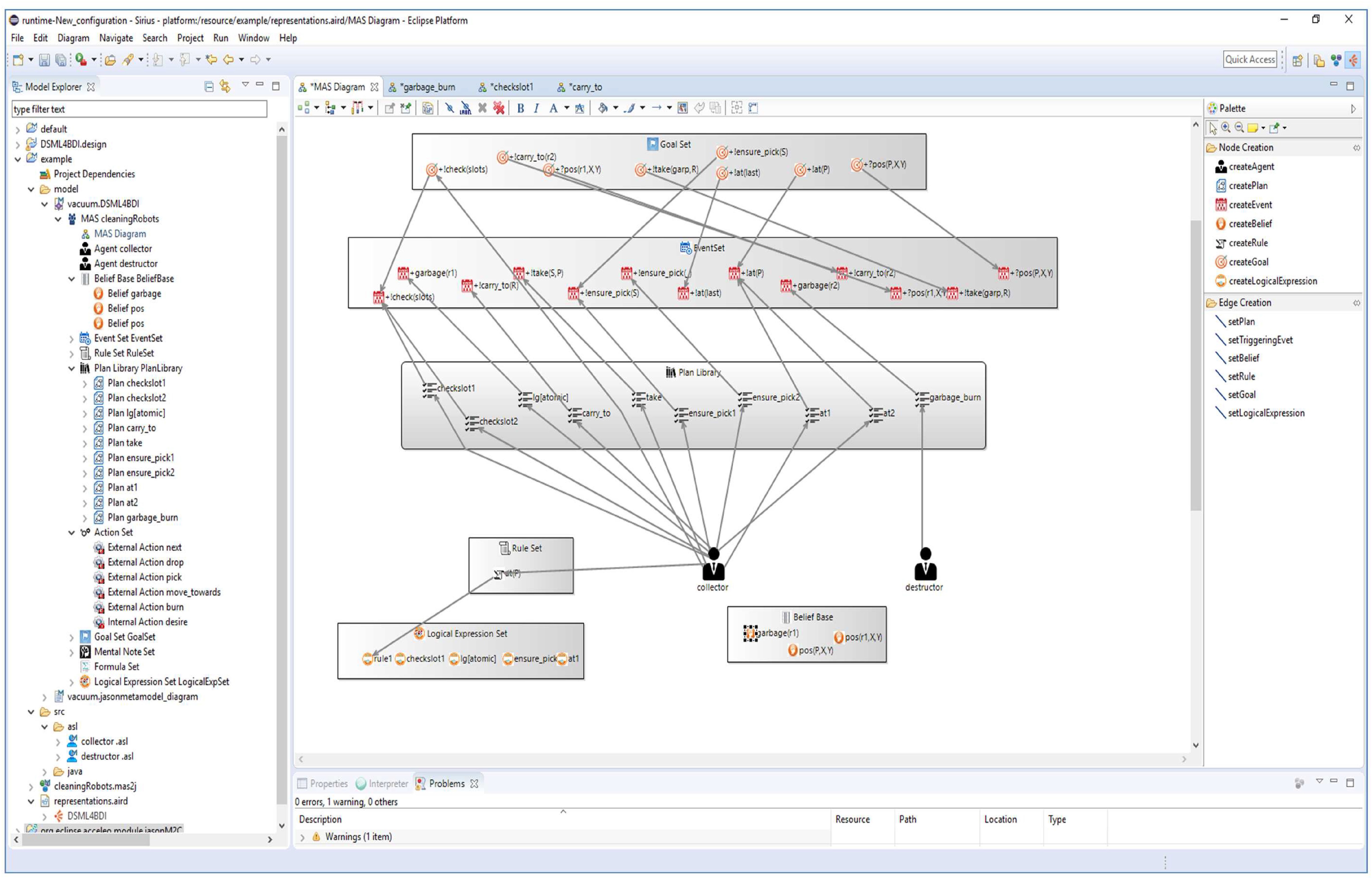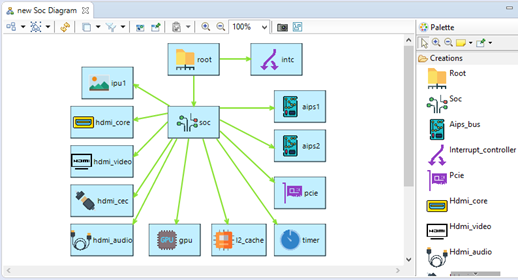From this page, open-source software tools and platforms, developed / being developed in Ege-SERLab, can be downloaded. Please note that versions of the tools are not stable and most of the tools are always under development. Hence, some incompatibility issues may arise during the installation and execution in different platforms. For more information and questions, please feel free to contact us.
List of software tools and platforms:
SEA_ML
SEA_ML is a domain-specific modeling language (with including a set of graphical tools) to model and generate architectural artifacts for Multi-agent Systems (MASs) especially working on the Semantic Web. It enables the developers to model the agent systems in a platform independent level and then automatically achieve codes and related documents required for the execution of the modeled MAS on target MAS implementation platforms. For example, it can generate codes for JADEX Belief-Desire-Intention (BDI) agents and semantic web service (SWS) files conforming to Web Ontology Language - Service (OWL-S) ontology.
SEA_ML Language consists of eight viewpoints. The user can graphically model his/her MAS system in SEA_ML tool using these viewpoints. Then, the developer can generate the Jadex, OWL, and OWLS models of his/her system. Finally, the developer can automatically generate related codes.
SEA_ML consists of eight viewpoints. The user can graphically model his/her MAS system in SEA_ML's tool using these viewpoints and then platform-specific system models (conforming to e.g. JADEX, OWL, OWL-S) and related codes can be automatically generated.
The first version of SEA_ML and its tool was released as the result of a bilateral project between Software Laboratory of International Computer Institute at Ege University, İzmir-Türkiye (Ege-SERLab) and Programming Methodologies Laboratory of Institute of Computer Science at University of Maribor, Maribor-Slovenia. The project was funded by the Scientific and Technological Research Council of Türkiye (TUBITAK) under grant 109E125 and Slovenian Research Agency (ARRS) under grant BI-TR/10-12-004.
SEA_ML is still an evolving language and its development and maintenance are currently provided by Ege-SERLab researchers.
The most recent version of SEA_ML and its tool can be found in the following links. Moreover, three case studies are provided including platform independent models, generated platform specific models, generated code, and instructions for each case study:
- Expert Finding System
- Stock Exchange System
- Electronical Barter System
Resources to download:
- SEA_ML all in one bundle can be found here (10,5 MB).
- SEA_ML metamodel can be downloaded from here (600 KB).
- Eclipse plugins for the graphical editor of SEA_ML is available here (7,15 MB).
- Model to model transformation tools implemented in ATL is available here (52 KB).
- Model to code transformation tools implemented in MOFScript is available here (33 KB).
- The example case studies designed in SEA_ML can be downloaded from here (162 KB).
- The readme file describing the instructions for installing and using SEA_ML is available here (7 KB).
- You can also download mofscript1.3.3 (2,5 MB)

MAS and Organization viewpoint designed for Expert Finding case study in SEA_ML

Agent Internal viewpoint designed for Expert Finding case study in SEA_ML

Agent-SWS Interaction viewpoint designed for Expert Finding case study in SEA_ML
DSML4BDI
DSML4BDI is a domain-specific modeling language, developed for the design and implementation of software agents according to well-known Belief-Desire-Intention (BDI) model. The syntax of the language provides the visual design of agent components required for the construction of multi-agent systems (MAS) according to the specifications of BDI architecture. Automatic code generation from the modeled agents for the Jason BDI platform is also possible inside the Sirius-based IDE of DSML4BDI.
The first version of DSML4BDI was released during a R&D project funded by the Scientific and Technological Research Council of Türkiye (TUBITAK) under grant 115E591.
Resources to download:
The most recent version of the language and its tool can be found in the bundle available here (684 MB) This bundle also includes the required Eclipse platform:
A 5-min. video demonstrating the use of the language can be found here:
https://www.youtube.com/watch?v=KrbgKBIf6us
DSML4BDI's IDE for MDD of BDI agents
DSML4DT
DSML4DT is a domain-specific modeling language for the design and implementation of device tree software. Device trees (DTs) provide description of devices and peripherals inside an embedded system with node specifications. However, developers mostly encounter difficulties in creating DT applications due to DT syntax different from the well-known general purpose programming languages. DSML4DT facilitates the design of DT specifications and enables the generation of the corresponding descriptions ready to be built and executed on various devices.
The first version of DSML4DT was released during a R&D project funded by the Scientific and Technological Research Council of Türkiye (TUBITAK) under grant 117E553.
Resources to download:
The most recent version of the language, its tool, help documents and other supplementary files can all be found in here

A screenshot from DSML4DT IDE showing how DT Core components and their relations can be modeled.

A screenshot showing a model of a system on a chip designed inside DSML4DT IDE.
SEA_L
SEA_L is a textual domain-specific language to model and generate architectural artifacts for Multi-agent Systems (MASs) especially working on the Semantic Web. It enables the developers to model the agent systems in a platform independent level and then automatically achieve codes and related documents required for the execution of the modeled MAS on target MAS implementation platforms. For example, it can generate codes for JADEX Belief-Desire-Intention (BDI) agents and semantic web service files conforming to Web Ontology Language - Service (OWL-S) ontology.
SEA_L Language consists of eight viewpoints. The user can textually model his/her MAS system in SEA_L tool using these viewpoints. Then, the developer can generate the Jadex, OWL, and OWLS models of his/her system. Finally, the developer can automatically generate related codes.
SEA_L consists of eight viewpoints. The user can textually model his/her MAS system in SEA_ML's tool using these viewpoints and then platform-specific system models and related codes can be automatically generated.
The first version of SEA_L and its tool was released as the result of a bilateral project between Software Laboratory of International Computer Institute at Ege University, İzmir-Türkiye (Ege-SERLab) and Programming Methodologies Laboratory of Institute of Computer Science at University of Maribor, Maribor-Slovenia. The project was funded by the Scientific and Technological Research Council of Türkiye (TUBITAK) under grant 109E125 and Slovenian Research Agency (ARRS) under grant BI-TR/10-12-004.
Development and maintenance of SEA_L are currently provided by Ege-SERLab researchers.
Resources to download:

Agent Internal viewpoint designed for E-Barter case study in SEA_L

Agent-SWS Interaction viewpoint designed for E-Barter case study in SEA_L
Formal SEA_ML Semantics
The semantic rules of the SEA_ML are implemented in Alloy and both model analysis and formal verification are realized using the popular Alloy analyzer (http://alloy.mit.edu/alloy/). In this page, all of the files, figures and codes for the description and use of the formal SEA_ML semantics can be found.
To make the Alloy codes more readable, we divided them in several files based on the SEA_ML viewpoints. Each file has only the signatures which are required exactly in the related viewpoint. Also, in order to reduce the complexity of the code, we omitted the unrelated relations and properties of a signature for the discussed viewpoint. For example, we have "plays" relation for Agent signature in Agent viewpoint, but not in MAS viewpoint.
Resources to download:
- The Alloy files for different SEA_ML viewpoints can be downloaded from here (5,9 KB).
- Each of the abovementioned Alloy files can be opened and executed in Alloy environment.
- You can download Alloy from: http://alloy.mit.edu/alloy/download.html

Transition among the viewpoints for the MessageAccess rule

Agent–SWS Interaction Paths

A SWA can play different roles at different times (rule)
MDD4SmartCards
MDD4SmartCards is an Eclipse plug-in which enables model-driven development of smartcard software conforming to ISO/IEC7816 standards. Developers can use the graphical user interface of the tool to model on-card applications without considering the details of underlying smart card architectures. Moreover, platform-specific counterparts of the models can be automatically achieved for two major smart card frameworks: Java Card and ZeitControl Basic Card. Developers can modify those auto-generated platform-specific models again in graphical modeling tools of MDA4SmartCards. If the developer wishes, creation of models for specific smart cards frameworks (e.g. Java Card) from scratch is possible. The plug-in can also automatically generate program codes of the modeled smart card systems both for Java Card and ZeitControl Basic Card architectures.
Download (538 MB)

A screenshot from the graphical modeling environment of MDA4SmartCards
DSL4JavaCard
DSL4JavaCard is a domain-specific language and tool for the development of smart card applications which can be deployed on Java Cards. The language's concrete syntax is driven from an Ecore-based metamodel of Java Card. Developers can design the components and their relations required for an on-card application in tree view. Eclipse-based integrated development environment of DSL4JavaCard enables the semantic control of the system to be built. In addition, Java Card program codes of the modeled systems can be automatically generated as the result of executing a series of model-to-text transformations.
Download (50 KB)

A screenshot from DSL4JavaCard's development environment
© (2025) Ege University Ege-SERLab.